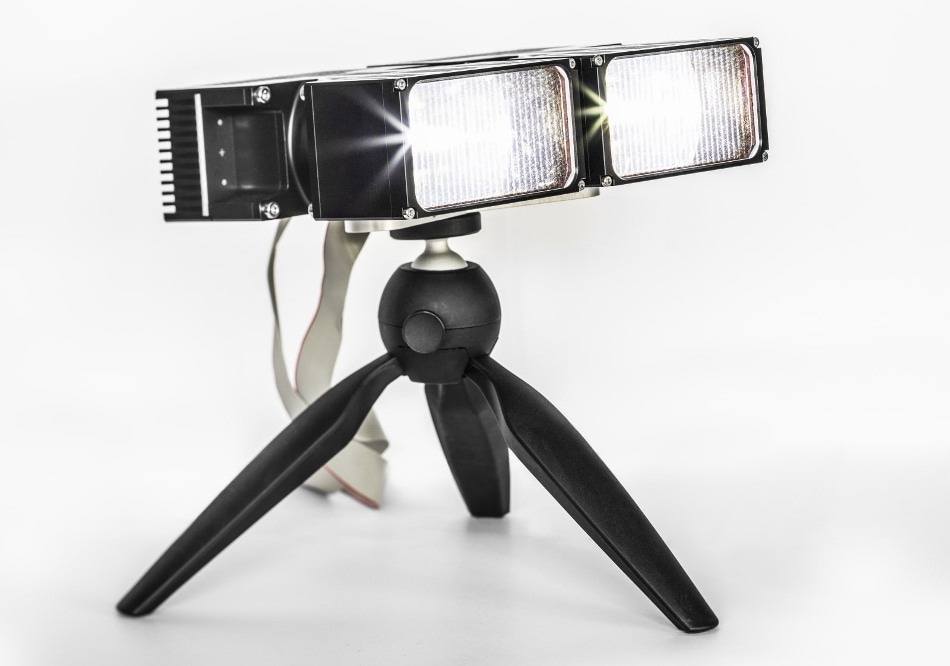Jun 4 2019
Success in the progressively competitive automobile sector can be attained mainly by those who combine well-engineered products with appealing design, for instance, through the ideal incorporation of headlamps. Fraunhofer scientists have created a new lighting technology that offers designers a lot of freedom to build vehicles with unconventional styling and also offers extra advantages to drivers and auto manufacturers equally. The prototype will be showcased at the LASER World of PHOTONICS trade fair.
 Segmented automotive LED high-beam unit realized as a micro-optical, irregular fly’s eye condenser. Two identical modules assembled with 1.5° rotation to one another. (© Fraunhofer IOF)
Segmented automotive LED high-beam unit realized as a micro-optical, irregular fly’s eye condenser. Two identical modules assembled with 1.5° rotation to one another. (© Fraunhofer IOF)
The Fraunhofer Institute for Applied Optics and Precision Engineering IOF in Jena has created a new generation of vehicle lights which not only surpasses legal and automotive-industry stipulations for and illumination functionality and performance, it is also more compact, more efficient, and considerably more flexible than existing systems with regard to their location on the vehicle.
200,000 micro-optical elements per headlamp
At the 2019 LASER World of PHOTONICS trade fair, researchers from Fraunhofer IOF will showcase the second functional prototype of a segmented high-beam unit which reduces light scatter. The unit is founded on a multi-aperture projector which has been in constant development for a number of years. 200,000 micro-optical elements aim the light perfectly in the vehicle’s direction of travel.
The segments can be deactivated as needed, either independently or in groups, without wasting time. Integrated with contemporary vehicle sensor technologies, this makes it viable to successfully stop the high beam from blinding oncoming motorists. Furthermore, the design requires considerably less installation space than conventional systems.
Reduced glare
Light be dimmed particularly for oncoming traffic as well as to protect pedestrians and, for example, cyclists without lights from being obstructed by glare. This enhances the safety level for all road users.
We’re developing the headlamp as part of the WISA project SSL – StructuredSpotLight – with Fraunhofer-internal funding. In-house research projects with commercial relevance enable cross-institute precompetitive research and lay the foundation for subsequent industry development projects.
Stephanie Fischer, Research Associate, Department of Micro-Optical Systems, Fraunhofer IOF
The project depended on a team of advisors from automotive manufacturers and suppliers of components. They were, thus, able to offer input on the preferred parameters of the high and low beam light as well as on the mechanical design necessities. Participants in the team include such prominent brand names as Trilux, HELLA, AUDI, and OSRAM.
Function follows design
Manufacturers of automobiles will gain in the near future from significantly greater creative freedom with regards to designing headlamps. Designers are, therefore, totally free to decide whether to fix the headlamps on the outer edges of the vehicle’s nose, as is typically done, or as a narrow strip spanning its center.
The reason is because the system allows a very tiny installation depth and offers much greater freedom with regards to shape and dimensions.
The headlamps no longer have to be rectangular: the designer can choose any other shape desired. Space requirements of larger optical units limited design possibilities in the past.
Stephanie Fischer, Research Associate, Department of Micro-Optical Systems, Fraunhofer IOF
Furthermore, the new system boosts the LED light yield. For instance, when fixed to low beam just 35% of the light yield is lost, an outstanding value for LED headlamps. This increase in productivity also enhances the energy balance in the vehicle and raises approval levels for automotive applications.
The high-beam unit comprises of two modules, each having seven independently controllable LED clusters. A total of four collimation lenses aim the light from the LED clusters onto two tandem lens arrays. These micro-optical elements deal with the distribution of the light from each LED. Thousands of micro-lenses exactly guide the light to the relevant illumination segments. Each segment can be turned on or off in a fraction of a second by separately controlling the total of 24 LEDs.
Production process developed in-house
For the first time, rectangular polymer lenses of different dimensions were used to realize more specific light modeling. The tiniest variant measures 0.045 mm x 0.180 mm. Here, Fraunhofer IOF created its own new manufacturing technique for rectangular lenses, the “High Five” grayscale lithography system. High Five can produce very fine microstructures, but can also develop the relatively large depth of profile (up to 100 μm) required to ideally manipulate the available luminance of the LEDs.
The first prototype of a low-beam headlamp module has now been effectively realized by Fraunhofer IOF. Once all the parts have been totally developed, 8 000 micro-lenses will ensure perfect visibility at night and in poor weather situations.
The scientists will present their findings at the LASER World of PHOTONICS trade fair in Munich held between June 24th and 27th, 2019 in Hall B3, Booth 327.